Introduction
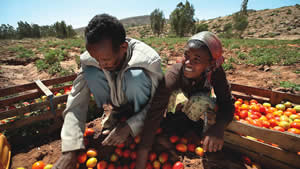
Feed the Future is a U.S. Government initiative that explicitly aims to improve nutrition through agriculture-led activities that also strive to reduce rural poverty in 19 focus countries. The initiative strives both to improve nutrition where it works and to contribute to the evidence base demonstrating how agriculture affects diet and nutrition for rural families. There is growing international agreement on key pathways1 and principles2 for improving nutrition through agriculture, as summarized in Understanding and Applying Primary Pathways and Principles (Brief 1). However, there is still a lack of well-documented examples of programming at scale that are required to improve our understanding of how agriculture can best contribute to improved nutrition.
This brief focuses on the pathway from food production to better diets and nutrition, illustrated in blue in the figure below. However, all of the pathways are interrelated. Agricultural activities typically affect more than one pathway and interact with the enabling environment that includes policies, the natural resource base, and cultural practices, among other factors.
Steps Toward Improved Nutrition: The Food Production Pathway
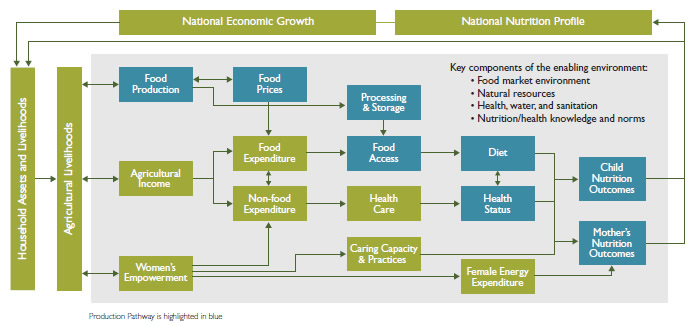
Food Production
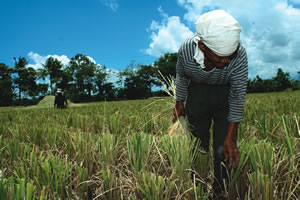
In this brief, vignettes illustrate the potential pathways from food production (see figure below) to improved nutritional status. Food production affects and is influenced by several factors.
The Food Market Environment: Availability, quality, safety, and pricing of food; convenience of access; information about food related to quality and nutritional value; and marketing—that is, how certain foods are being promoted for sale and consumption.
Natural Resources: Access to land and water; the effects of climate change as they affect land and water.
Health, Water, and Sanitation: Health risks from production practices and chronic or seasonal illnesses.
Typically, smallholder households are net food buyers— that is, they purchase more food than they consume from their own production. Thus, what is available in markets affects their food purchases and their diet. Smallholders also usually produce some amount of food for household consumption to secure access to foods they need or prefer. It may be less expensive or more convenient to grow some foods than to buy them, particularly considering the cost of women's time and the fact that women may not always control the income needed to obtain nutritious food for the family.
From the Feed the Future Learning Agenda
Food Production in Focus
- What activities have enabled food crop value chain investments to lead to improved consumption of diverse diets?
- Does including nutrition education and SBC in agriculture extension services help reduce or eliminate household hunger and improve dietary diversity?
- What approaches successfully address long-term natural resource management objectives while effectively increasing productivity and profitability?
To date, biofortification initiatives such as those focusing on the production of orange-fleshed sweet potato have generally targeted the household farming system. Over the long term, however, they also aim to increase availability of more micronutrient-dense food in markets. Homestead food production activities have also illustrated the important role the household farming system plays in decisions related to diets and nutrition. These activities aim to boost production for household consumption of fruits, vegetables, legumes, and animal-sourced foods. The evidence of success for these initiatives is mixed, however; implementers have reported an increase in consumption of these nutrient-dense foods, as well as in promotion of greater dietary diversity, but impact on stunting from purely homestead food production has not been documented. Impact on diets has been stronger where nutrition education, social and behavior change (SBC), and women's empowerment interventions have been incorporated (Ruel and Alderman 2013; Webb Girard et al. 2012).
Many current studies, including some within Feed the Future, are measuring overall dietary impact of interventions that mainly target the household farming system (Herforth and Ballard, forthcoming). In contrast, few value chain activities are monitoring or measuring impact on natural resources, food availability, and market prices or aspects of the health environment (e.g., water quality or disease risk). These areas of potential impact are important to consider in designing and implementing Feed the Future activities.
Through its learning agenda,3 Feed the Future is committed to learning by doing and strengthening the evidence base. In particular, filling the research gaps highlighted above can help answer some of the learning agenda's key questions.
The following vignettes provide information relevant to some of these questions. They shed light on how, within specific contexts, agriculture and nutrition strategies and activities can be effectively linked to ensure that people in target communities are well fed.
Agriculture Production to Nutrition in Focus: Guatemala
Every morning in Guatemala's Western Highlands, Don Elmer and Doña Natalia greet 10 local children under five at the door of their small house, offering each a glass of goat's milk. As participants in the PROMASA II activity, Don and Doña are not only helping their community's malnourished children, but also learning better crop production practices, gaining marketing skills, and raising their household income.
Programa Maya de Seguridad Almentaria II (PROMASA II)
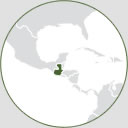
Country: Guatemala
Implementer: Save the Children
Timeframe: 2007–2012
Key Interventions: Food crop and animal production; nutrition SBC; income generation; natural resource management
In exchange for agreeing to provide milk daily to their community's undernourished children, 1,983 smallholder farmers in the Western Highlands of Guatemala received goats under an integrated food security activity, PROMASA II. The activity supported homestead food and crop production, soil and water management, and improved practices for infant and young child feeding and care. Most beneficiary families had young children of their own, and were able to provide milk both for them and for the community's undernourished children. Many participants were also able to sell excess milk, milk products, and their goats' kids to other local residents. Elmer and Natalia, who also grew corn and beans, began earning more money soon after joining PROMASA II; within two years their household earnings had doubled. After technicians showed the couple how to use goat droppings to fertilize their corn, they reduced fertilizer expenses and also realized a 10% increase in production, which meant more maize for consumption during the coming year.
Opportunities for Nutrition Linkages
This activity exemplifies how the production-to-consumption and income-to-purchase pathways can interact. Evidence has shown that increased production, income, or knowledge of nutrition alone will not have an impact on stunting. PROMASA II integrated strategies for increasing both income and food availability and diversity, including increased access to animal-source food. Crossing both components is a comprehensive SBC strategy focused on household- and community-level understanding of maternal, infant, and young child feeding and care practices. This design highlights key opportunities for linking agriculture and nutrition:
Food Production: PROMASA II supported increased availability of diverse nutritious foods at the household level. In addition, it built skills and knowledge while providing inputs to help raise family incomes. The combined approaches helped move beneficiaries along the pathway from food production to improved food access and likely to improved nutrition for children as well.
Food Market Environment: Even when access to food is improved, the availability of diverse, nutritious foods in the marketplace is also essential. Increased production can help stabilize local market supplies and thus support increased consumption in target communities.
Nutrition/Health Knowledge and Norms: PROMASA II worked to increase community knowledge about practices essential to good nutrition. Community commitment to improving access to animal-source food for young children is commendable, however, it has yet to be seen whether the new social norms—specifically the practice feeding others' children—will take hold, and thus ensure the sustainability of this approach.
Natural Resource Environment: PROMASA II linked animal production to farming practices that improve soils and reduce use of chemical fertilizers. However, awareness of any new farming technique's potential for adverse health impact (e.g., zoonotic disease) is also required.
Agriculture Production to Nutrition in Focus: Burkina Faso
In the Burkina Faso village of Bassalga, on a model homestead farm planted with rows of vegetables, women gather to find out how to grow healthy foods near their own homes. They learn about everything from improved planting techniques to pest management. Touring the metal-fenced field, the women examine sweet potato vines, okra plants, moringa trees, and mango saplings; a pregnant, well-fed goat is nearby, and chickens rest inside a small hut. Other days, they gather around huge pots of thick soup, learning how the foods they grow can become nutritious meals for their growing children.
Enhanced Homestead Food Production (EHFP)
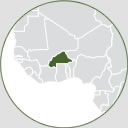
Location: Eastern Region, Burkina Faso
Implementer: Helen Keller International
Timeframe: 2009–2012
Key Interventions: Homestead food production; nutrition SBC
Between 2009 and 2012, Helen Keller International (HKI) implemented the Enhanced Homestead Food Production (EHFP) activity in an area of Burkina Faso with consistently high levels of undernutrition and severe hunger. The objectives were to reduce stunting and anemia in children who were less than a year old at the start of the activity, and to increase food security for targeted households. On EHFP Village Model Farms, groups of women learned agricultural production techniques useful for raising chickens and goats, and growing beans or other vegetables. The women initially received seeds and a few animals to begin production at home. In addition, a complementary nutrition SBC strategy promoted Essential Nutrition Actions (ENA) to caregivers and helped ensure that foods grown at the household level were contributing to child and maternal health. HKI facilitators, with nongovernmental organizations (NGOs) from multiple sectors and government partners, delivered coordinated social and behavior change messages. After three years, EHFP met the majority of its training targets and produced some improvements in nutrition practices. Nonetheless, the prevalence of stunting and anemia was not significantly different between children studied in intervention groups and in control groups.
Opportunities for Nutrition Linkages
Following the food production pathway can help those designing and implementing homestead food production activities improve the possibility that their agricultural activities will improve nutrition outcomes. The more thought given to moving along the pathway and to the relevant programming principles, the greater the likelihood of positive nutrition outcomes. Examples of the pathway components and programming principles involved in EHFP include:
Nutrition/Health Knowledge and Norms: Along with increased access to and availability of diverse, nutritious foods at the household level, EHFP delivered coordinated messaging on nutrition—with cooking demonstrations and an emphasis on ENA—to directly link production and consumption.
Multisectoral Collaboration: EHFP's design relied on partnerships from multiple sectors; contributions ranged from trainings for beneficiaries to technical guidance. Four NGOs, six ministries, and local and regional political leaders were represented on an active pilot committee. This committee gave each sector or organization opportunities to provide input on both the original activity design and on subsequent adjustments required in the field due to implementation challenges.
Health, Water, and Sanitation: Small-scale homestead food production and nutrition messaging yielded improvements in children's minimum acceptable diet and in breastfeeding practices but did not move stunting or anemia indicators. Post-activity review identified that insufficient emphasis on water, hygiene, and sanitation (WASH) left children susceptible to sicknesses, affecting their nutritional status. In response, HKI is developing a full WASH package for the follow-on activity.
Conclusions and Observations on the Application of Pathways and Principles
Programming Principles
- Incorporate explicit nutrition objectives and
indicators into design.- Assess the local context.
- Target the vulnerable and improve equity.
- Collaborate and coordinate with other sectors.
- Maintain or improve the natural resource base, particularly water resources.
- Empower women.
- Facilitate production diversification, and increase production of nutrient-dense crops and livestock.
- Improve processing, storage, and preservation of nutritious food.
- Expand market access for vulnerable groups, and expand markets for nutritious foods.
- Incorporate nutrition promotion and education that builds on local knowledge.
The pathways and principles are useful frameworks for exploring how current interventions are working to achieve nutritional goals. The vignettes presented in this brief demonstrate how activities use the food-productionto- food-access-and-consumption pathway in pursuit of nutritional goals. PROMASA II underscores a characteristic common to most food production activities: production is integrated with income generation. Thus, the activities work along multiple pathways. Similarly, homestead food production activities such as HKI's EHFP frequently target women; therefore they are also operating along the women's empowerment pathway. It is critical for a homestead food production activity to consider demands on women's time and their control of resources to ensure successful movement along both pathways toward improved nutritional outcomes.
Both examples further highlight the necessity of applying key programming principles for improving nutrition through agriculture while working along the food production- to-consumption pathway. Coordinating with other sectors, improving the natural resource base, facilitating production diversification, and incorporating nutrition education are featured in the food production vignettes in this brief. All 10 programming principles (left) can be factored into program design and implementation.
The pathways and principles provide a powerful framework for confirming assumptions and defining causal relationships between activity components, which are critical to activity design, monitoring, and evaluation. In applying the pathways and principles described above and illustrated in the vignettes, Feed the Future presents opportunities for learning at scale. Use of appropriate process monitoring indicators and sharing examples from the field are two ways for Feed the Future to build evidence on how food production can work to improve nutrition.
Footnotes
1 The conceptual pathways between agriculture and nutrition help us understand and measure how various agricultural investments or activities could improve access to food and health care; how they affect and are affected by the enabling environment; and how they ultimately affect the nutrition of women and children.
2 The principles are the current global consensus of key recommendations for improving nutrition through agriculture. Download the Principles
3 USAID's Bureau for Food Security has established a learning agenda for Feed the Future that includes a set of strategic questions intended to produce evidence, findings, and answers primarily through impact evaluations, performance evaluations, and policy analysis. Through the learning agenda, Feed the Future will contribute to the body of knowledge on food security to improve the design and management of interventions in the agriculture and nutrition sectors. Download the Learning Agenda
References
Herforth, Anna, and Jody Harris. 2014. Understanding and Applying Primary Pathways and Principles. Brief 1. Improving Nutrition through Agriculture Technical Brief Series. Arlington, VA: USAID/Strengthening Partnerships, Results, and Innovations in Nutrition Globally (SPRING) Project.
Herforth, Anna, and Terri Ballard. Forthcoming. "Survey of Nutrition Indicators in Agriculture: What Is Being Measured, What Is Not Measured, and What Can We Expect to Learn?"
Ruel, Marie T., and Harold Alderman. 2013. "Nutrition-Sensitive Interventions and Programmes: How Can They Help to Accelerate Progress in Improving Maternal and Child Nutrition?" The Lancet 382:536–551. doi:10.1016/S0140-6736(13)60843-0.
Webb Girard, Amy, Julie L. Self, Corey McAuliffe, and Olafunke Olude. 2012. "The Effects of Household Food Production Strategies on the Health and Nutrition Outcomes of Women and Young Children: A Systematic Review." Paediatric and Perinatal Epidemiology 26 (Suppl. 1): 205–222. doi:10.1111/j.1365-3016.2012.01282.x.
Recommended Citation
SPRING. 2014. Understanding the Food Production Pathway. Brief 2. Improving Nutrition through Agriculture Technical Brief Series. Arlington, VA: USAID/Strengthening Partnerships, Results, and Innovations in Nutrition Globally (SPRING) Project.